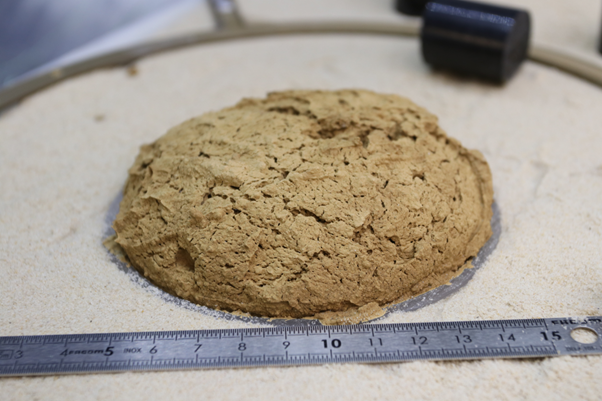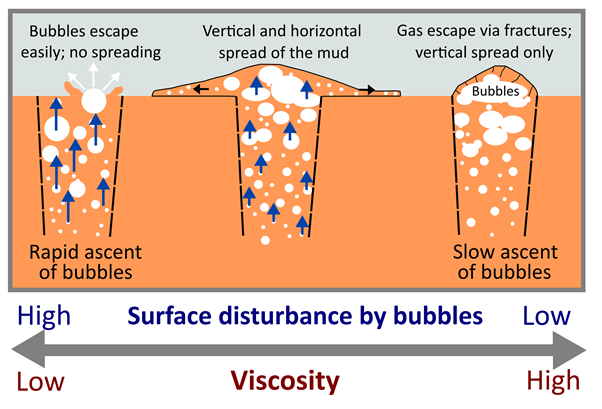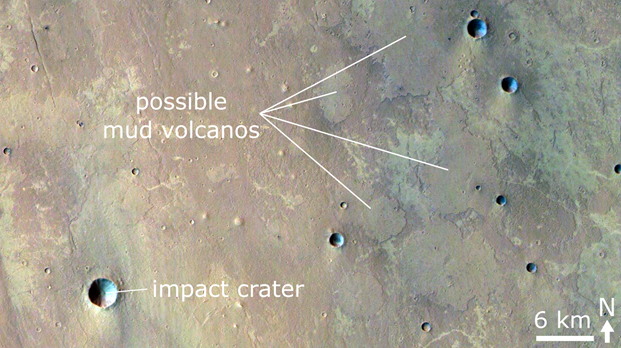A team of scientists has investigated the effect of the different environmental conditions when mud is emplaced on the surface of the planet Mars, also known as the Red Planet.
They found that mud on Mars surface behaves very differently to mud on Earth. The low atmospheric pressure (~6 mbar) on the planet causes water to become unstable, and mud which consist of some amounts of water evolves in a way that resembles sourdough bread during baking, they found in their studies.
The international team, led by Mgr. Petr Brož, an researcher at the Institute of Geophysics of the Czech Academy of Sciences, performed their experiments in the "Mars Chamber" at The Open University, UK, exposing mud samples to simulated Martian surface conditions.
The findings was published in the Journal of Geophysical Research: Planets, results which can help scientists re-interpret geomorphological features on Mars, and could shed light on understanding what is happening on other bodies in the Solar System.
Low pressure makes mud to behave like baking bread
On Mars's surface, the average atmospheric pressure is about 160 times lower than on Earth, therefore, liquid water cannot be present for long periods of time. This is why it is difficult for surface water to flow on present-day Martian crust surface. This concept applies not only to water, but also to a mixture of water and small clay-sized grains – what we know as mud.
Previous research has shown that the formation of an ice crust on the surface of the mud prevents Martian mud flows to move like water. Instead, they move like pahoehoe lava in Hawaii or Iceland. During this process, the mud flows under a protective layer of an icy crust which occasionally cracks.
When this occurs, the mud is squeezed out through the cracks and begins to form a new flow lobe which forms its own ice shell, thus creating gradually overlapping lobes.
– This process can only be only applied to water-rich muds, which flow very well. But we were interested in what happens when the amount of water in the mud decreases. That is, how will mixtures that are much harder to flow behave. What the mud volcanoes formed by the harder flowing muds would look like has remained shrouded in mystery, to date, says Petr Brož, lead author of the study.

Laboratory simulations in the "Mars Chamber"
The research team decided to perform laboratory simulations in the low-pressure chamber at the Open University in Milton Keynes (UK), into which they placed mud samples of varying water content. The mud samples were then exposed to Martian atmospheric conditions of 6 mbar.

At these low-pressure conditions water starts boiling and the produced bubbles may escape very slowly or not at all from highly viscous muds. Viscous, slow-flowing muds exposed to Martian pressure behave a bit like sourdough bread during baking. They gain volume due to the formation of many bubbles. One of the scientists behind the research, Adriano Mazzini explains what they found.
– Our experiments revealed different behaviours of the mud. Low viscosity muds just bubbled up and the volume remained unaltered; the water-poor muds instead began to show a visible increase in volume. This is happening because during the boiling, water bubbles do not escape easily and therefore the whole mud volume increases. This suggests that mud on the Red Planet’s surface has a completely unexpected behaviour. As a consequence, the Martian mud eruption are likely to produce very different morphologies compared to those observed on Earth, says Mazzini.

Adriano Mazzini is a research scientist at the Dept. of Geosciences, University of Oslo and the Institute for Energy Technology, Norway, and is an expert on mud volcanoes on Earth.
– Since reduced atmospheric pressures in comparison to Earth are not only present on Mars, but also on other bodies in the Solar System, the experiments have also given us insight into how water or mud outflows might behave on other worlds. For example, Europa, Ceres, or Enceladus, where we assume that water sometimes reaches the surface during the process of cryovolcanism, he continues.
New knowledge to understand surfaces on planets
The team's findings about mud and mud volcanoes on the surface on Mars will help to understand processes that could occur far beyond Mars, and that's what's valuable about it.
When looking at the surface of Mars, and other worlds, we will now have a greater opportunity to identify the processes at work and identifying analogous processes we know from Earth. This will allow us to better plan our further exploration of these distant worlds. concludes the importance of Brož's research.
A film explains the research and show the lab experiments, see it on YouTube.
Link to the movie: https://youtu.be/whrbMCXvCGY
Contacts:
Mgr. Petr Brož – Principle investigator of the study, petr.broz (at) ig.cas.cz +420 721 736 424
Adriano Mazzini – Coauthor E-mail: adriano.mazzini (at) geo.uio.no Tel: +47 228 56108
Reference to the article:
Brož,P.,Krýza,O.,Patočka,V.,Pěnkavová,V.,Conway,S.J.,Mazzini,A., et al. (2023).Volumetric changes of mud on Mars: Evidence from laboratory simulations. Journal of Geophysical Research: Planets, 128, e2023JE007950. doi.org/10.1029/2023JE007950
